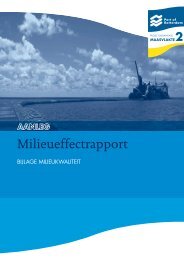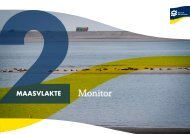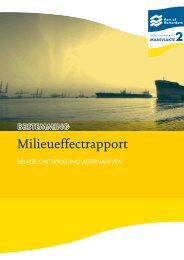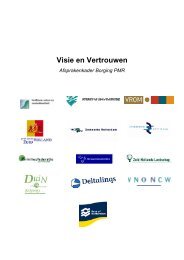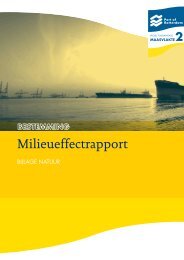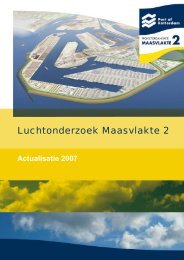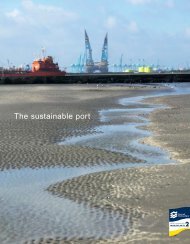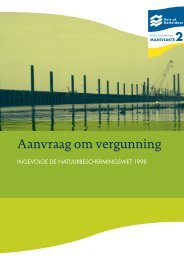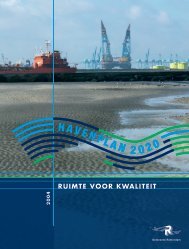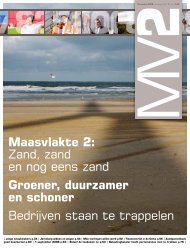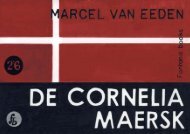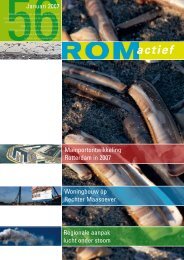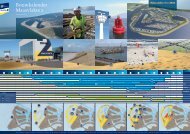Factsheet Sand extraction - Maasvlakte 2
Factsheet Sand extraction - Maasvlakte 2
Factsheet Sand extraction - Maasvlakte 2
- No tags were found...
You also want an ePaper? Increase the reach of your titles
YUMPU automatically turns print PDFs into web optimized ePapers that Google loves.
<strong>Sand</strong> <strong>extraction</strong>:<strong>Sand</strong> for landAn enormous amount of sand is required to build <strong>Maasvlakte</strong> 2, Rotterdam’snew port area in the North Sea – probably some 365 million m³. This is enoughsand to fill the Rotterdam Feyenoord soccer stadium ‘De Kuip’ to the raftersnearly 250 times over.SAND EXTRACTION PITMost of the sand used for <strong>Maasvlakte</strong> 2 will be extractedfrom an offshore sand pit. The best site for sand <strong>extraction</strong>was selected after extensive research. This was no simpletask, incidentally, as there are quite a few restrictions. Thefinal selection had to take account of nature areas, munitionsdumps, military training grounds, cable and pipeline corridorsand archaeological sites. The future sites of wind turbinesare also ‘off limits’. In addition, the heavy off-coast shippingtraffic must remain able to safely navigate this zone.It is common to extract sand to a depth of some two metres,but in consideration of the amount of sand required toconstruct <strong>Maasvlakte</strong> 2, this would mean removing a sectionof North Sea sea bed of approximately 11 by 30 kilometres.Therefore, in the case of <strong>Maasvlakte</strong> 2, sand will beextracted to a maximum depth of 20 metres, to ensure that asmaller section of the seabed is put under pressure.off the sea bed using a draghead connected to a suctiontube. The suction tube transports the sand to the ship’shold. Once the hold is filled up, the TSHD moves to the<strong>Maasvlakte</strong> 2 construction site to unload the sand.RECYCLINGThe sand required for the land reclamation project will not allbe extracted off the North Sea coast. A small share (some15%) can be obtained from sites directly adjacent to thenewly constructed site. For example, suitable sand willbecome available when the Yangtzehaven is extended andNorth SeaSAND EXTRACTIONThe preferred ship for working the offshore sand pits is theTrailing Suction Hopper Dredger – TSHD for short. Movingslowly through the water, this type of dredger scrapes sandN<strong>Sand</strong> <strong>extraction</strong> site010 km
<strong>Sand</strong> for landEXTRACTION TURNOVERIn order to round off the first phase of <strong>Maasvlakte</strong> 2 on time,from the start of activities a maximum of 150 million m³ ofsand per year needs to be extracted. This equals some24,000 TSHDs loaded to full capacity.CONSTRUCTION ON SCHEDULEThe construction of <strong>Maasvlakte</strong> 2 is carried out in phases.In effect, the phases are determined by the rate at which thePort of Rotterdam Authority is able to enter into contractswith clients. This prevents sites from being sprayed on whileno clients have been attracted for them yet.After an international call for bids, the PUMA (ProjectUitbreiding <strong>Maasvlakte</strong>) consortium was awarded thecontract for constructing the first sites. PUMA is apartnership between Boskalis and Van Oord. All in all, thisfirst phase involves some 700 ha of new port sites. The firstphase requires 240 million m³ of sand. Upon completing theproject in 2013, PUMA will also bear responsibility for themaintenance of the seawall for a period of five years.MULTIPLE APPLICATIONS<strong>Sand</strong> will be required for various operations in the<strong>Maasvlakte</strong> 2 project:• The construction of a 11 km seawall on the western edgeof the land reclamation. Two-thirds of this structure will bea soft seawall consisting of sprayed-on beach and dunes;one-third will be a hard seawall (with a sand core).• The spraying on of the new port sites.• The construction of new dunes to the north of Hoek vanHolland. This project will be realised to compensate fordamage inflicted to existing dunes and to reinforce theDelfland coast.widened. This port basin will be the new area’s entrancechannel from the North Sea. In addition, sand will becomeavailable when the port basins and waterways are excavatedin the land reclamation of <strong>Maasvlakte</strong> 2.QUALITY REQUIREMENTS<strong>Sand</strong> quality is a key concern when extracting sand forthe reclamation. Coarse-grained sand is preferred for theconstruction of the soft seawall for <strong>Maasvlakte</strong> 2. This sandis flushed away less easily by the tide, which helps keepmaintenance costs down. In other sub-projects such as thespraying on of new industrial sites, the sand’s average grainis less of an issue.This section is also covered by the contract. The remainderof the sites will be constructed as soon as there is a demandfor them. Around 2030, <strong>Maasvlakte</strong> 2 will be fully developedand operational.CARE FOR THE ECOSYSTEMOffshore sand <strong>extraction</strong> has an impact on the species livingon and beneath the sea floor and the movement of wateraround the sand pit itself. The effects of sand <strong>extraction</strong>activities have been extensively researched. The mostimportant effect is that silt will be released back into the waterduring <strong>extraction</strong>, which clouds the water. In addition, therecan be sound pollution in the area – both above and belowthe water surface. These possible effects have been deemed‘not significant’. In order to establish the actual consequencesof the construction of <strong>Maasvlakte</strong> 2, the environmental impactwill be closely monitored throughout the project.All large-scale projects within the Netherlands must bepreceded by an Environmental Impact Assessment (EIA).This mandatory report describes the consequencesof a specific project for the environment and the localsurroundings. The EIA dealing with the constructionof <strong>Maasvlakte</strong> 2 outlines, among other things, theconsequences of the sand <strong>extraction</strong> activities. In addition,the EIA report includes measures that should be takento alleviate the project’s negative impact and possiblecompensatory measures.<strong>Maasvlakte</strong> 2The NetherlandsEuropeRotterdamRotterdamport areaThe NetherlandsNorth Sea201005ID-M012-ERotterdam Mainport Development ProjectMore information?The construction of the new port area, <strong>Maasvlakte</strong> 2, is part of Port of Rotterdam Authoritythe Rotterdam Mainport Development Project (PMR). This project <strong>Maasvlakte</strong> 2 Project Organizationalso includes environmental compensation measures connected PO Box 6622to the construction, the development of a 750 ha area for nature 3002 AP Rotterdam,and recreation and improvements to the Existing Rotterdam Area. The NetherlandsPMR is a partnership between national and regional government T +31 (0)10 252 25 20and the Port of Rotterdam Authority. For further information, info@maasvlakte2.complease visit www.mainport-pmr.nl.www.maasvlakte2.com© Port of Rotterdam Authority • <strong>Maasvlakte</strong> 2 Project Organization (0510/E) • No rights can be derived from this textWANT TO EXPERIENCEMAASVLAKTE 2?Visit the FutureLand information centerwww.futureland.nl



